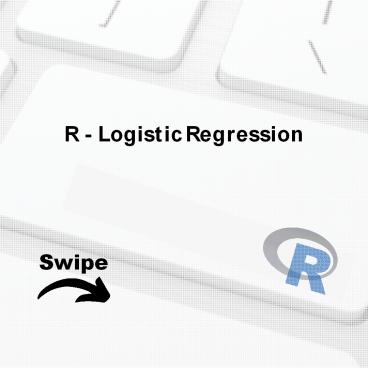R - Logistic Regression - PowerPoint PPT Presentation
Title:
R - Logistic Regression
Description:
This presentation educates you about R - Logistic Regression, and glm() function with description parameters including sample example, Input Data for glm() function, Create Regression Model. For more topics stay tuned with Learnbay. – PowerPoint PPT presentation
Number of Views:128
Title: R - Logistic Regression
1
R - Logistic Regression
Swipe
2
R - Logistic Regression
The Logistic Regression is a regression model in
which the response variable (dependent variable)
has categorical values such as True/False or
0/1. It actually measures the probability of a
binary response as the value of response
variable based on the mathematical equation
relating it with the predictor variables. The
general mathematical equation for logistic
regression is- y 1/(1e-(ab1x1b2x2b3x3...
))
3
Following is the description of the parameters
used- y is the response variable. x is the
predictor variable. a and b are the coefficients
which are numeric constants. The function used
to create the regression model is the glm()
function.
4
glm() function
The basic syntax for glm() function in logistic
regression is- glm(formula,data,family) Followin
g is the description of the parameters
used- formula is the symbol presenting the
relationship between the variables. data is the
data set giving the values of these
variables. family is R object to specify the
details of the model. It's value is binomial for
logistic regression.
5
Example
- We have the in-built data set "warpbreaks" which
describes the effect of wool type (A or B) and
tension (low, medium or high) on the number of
warp breaks per loom. - Let's consider "breaks" as the response variable
which is a count of number of breaks. - The wool "type" and "tension" are taken as
predictor variables.
6
Input Data for glm() function
input lt- warpbreaks print(head(input)) When we
execute the above code, it produces the
following result- breaks wool tension
1 26 A L
2 30 A L
3 54 A L
4 25 A L
5 70 A L
6 52 A L
7
Create Regression Model
We use the glm() function to create the
regression model and get its summary for
analysis. input lt- mtcars,c("am","cyl","hp","wt"
) am.data glm(formula am cyl hp wt,
data input, family binomial) print(summary(a
m.data)) When we execute the above code, it
produces the following result-
8
Call glm(formula am cyl hp wt, family
binomial, data input) Deviance Residuals
Min 1Q Median -2.17272 -0.14907 -0.01464
3Q Max 0.14116 1.27641
Coefficients Estimate Std. Error z value
Pr(gtz) (Intercept) 19.70288 8.11637 2.428 0.015
2
cyl 0.48760 1.07162 0.455 0.6491
hp 0.03259 0.01886 1.728 0.0840 .
wt -9.14947 4.15332 -2.203 0.0276
---
Signif. codes 0 0.001 0.01 0.05
. 0.1 1 (Dispersion parameter for binomial
family taken to be 1) Null deviance 43.2297 on
31 degrees of freedom Residual
deviance 9.8415 on 28 degrees of freedom AIC
17.841 Number of Fisher Scoring iterations 8
9
Topics for next Post
R - Normal Distribution R - Binomial
Distribution R - Poisson Regression Stay Tuned
with































